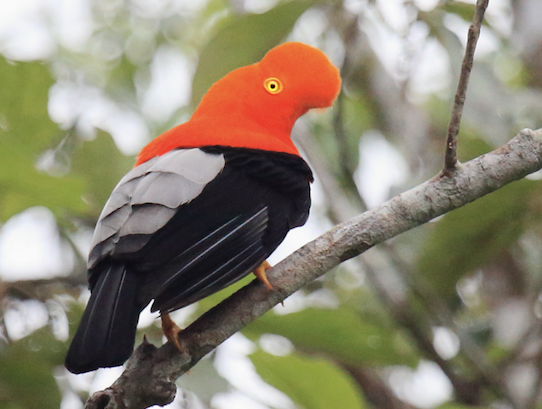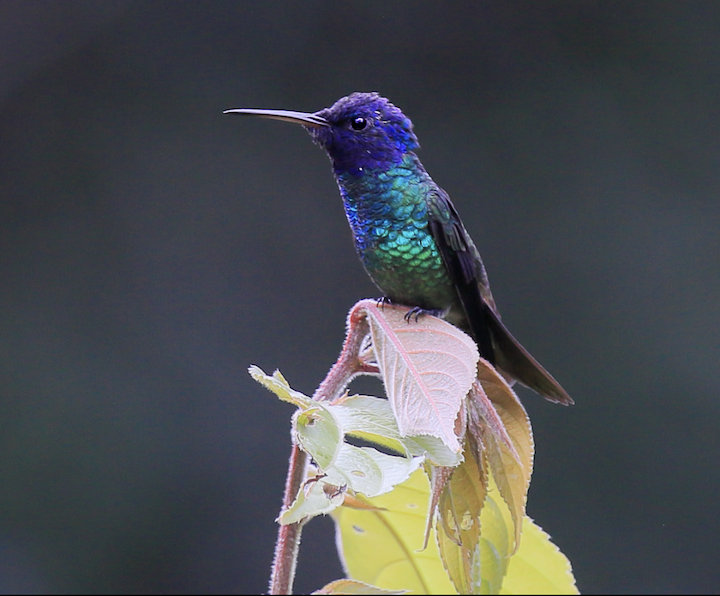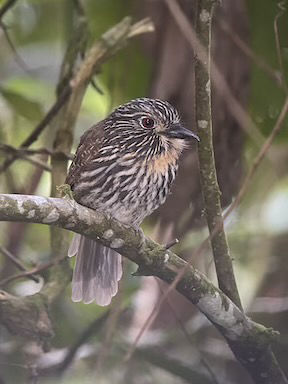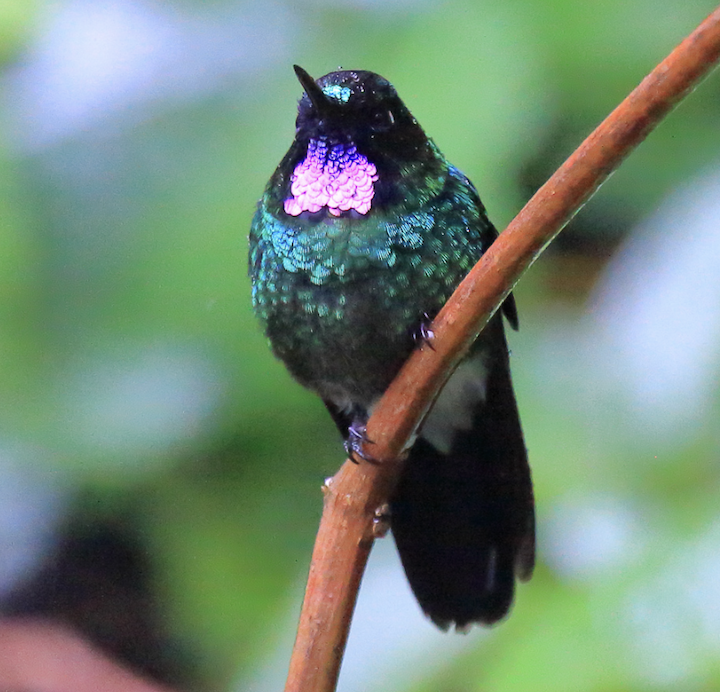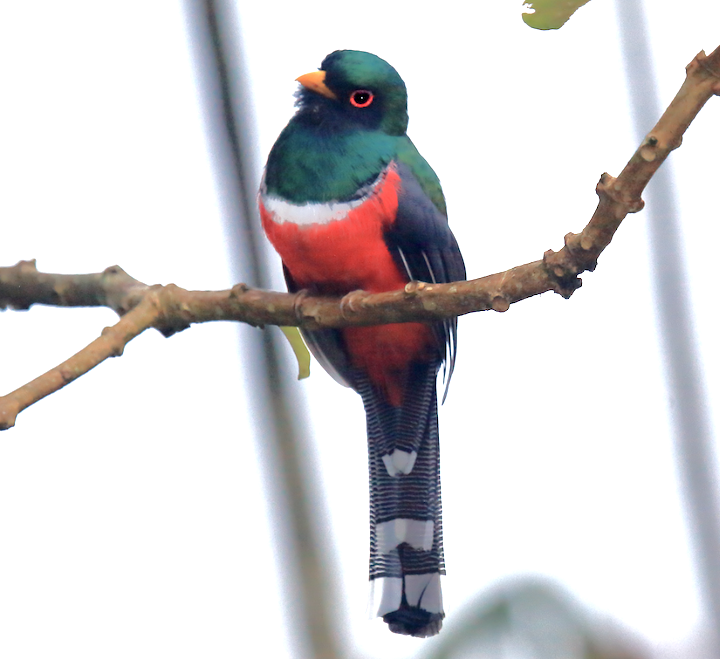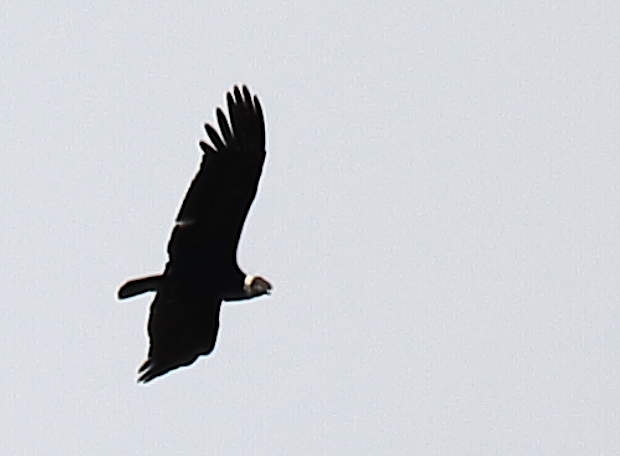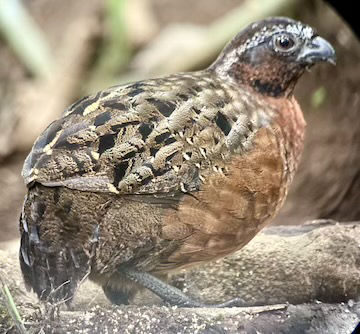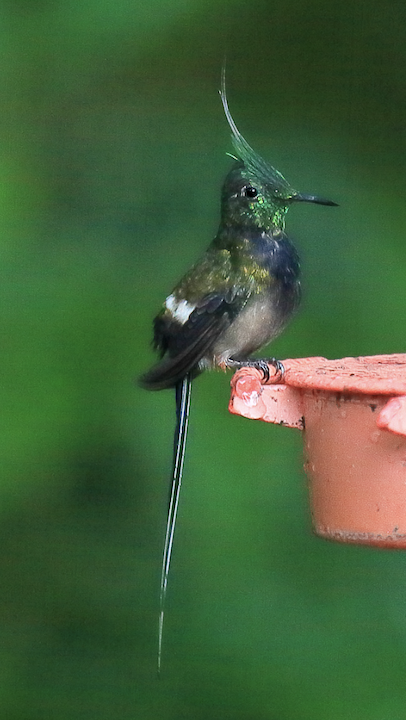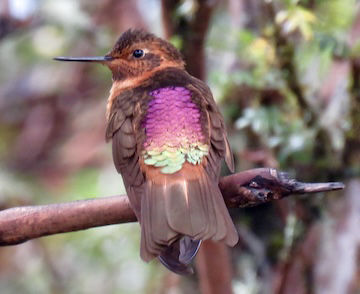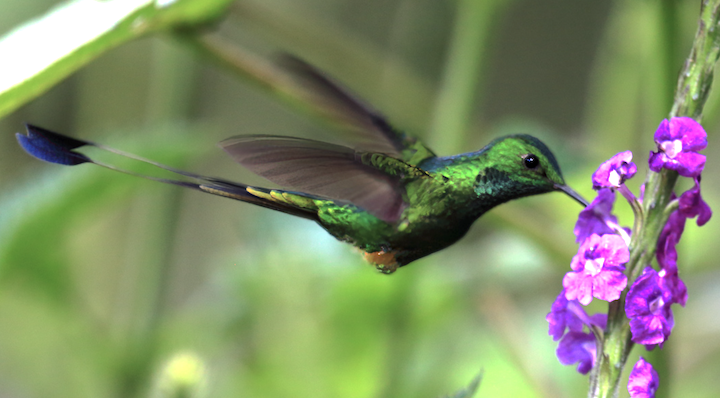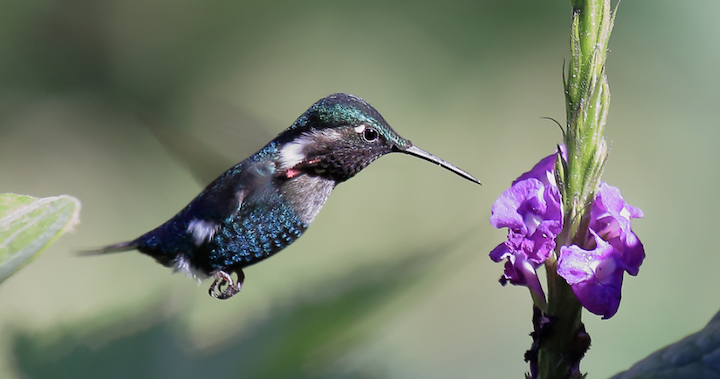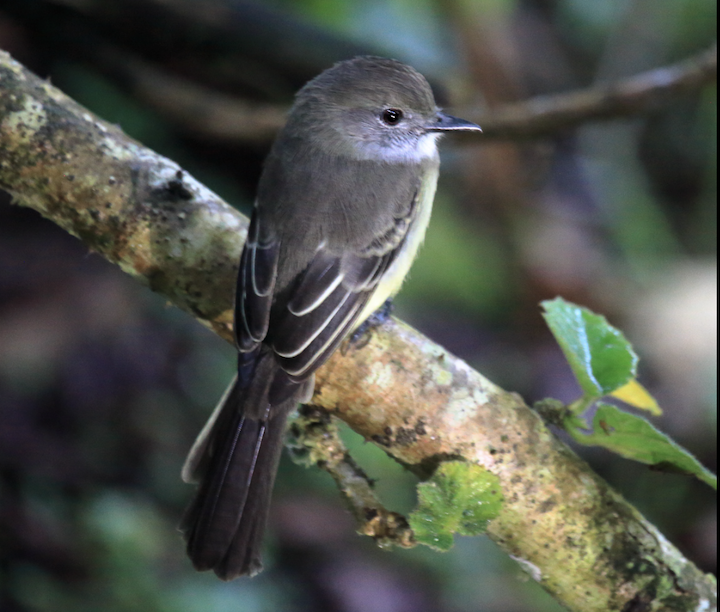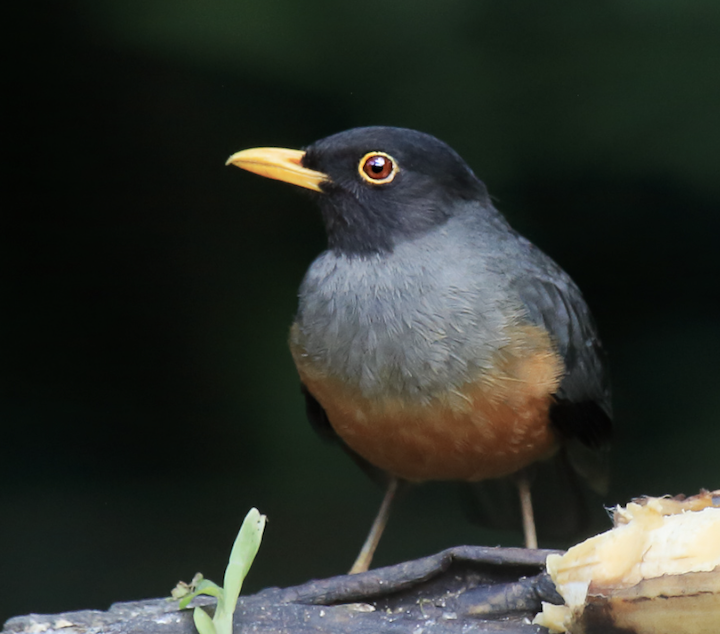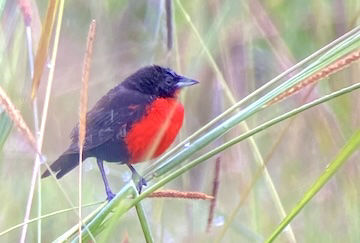It was Alexander Von Humboldt who, during his explorations in Ecuador in the early 1800s, was the first to coin the concept of climate zones. And it was VENT’s Eastern Slope of the Andes tour, in Ecuador this January, that once again was able to confirm his findings. Each distinct altitudinal realm that we visited offered up a smorgasbord of exotic local delights!
Andean Cock-of-the-rock © Mary Stephens
A part of our group navigated upstream along the Río Napo—returning from the Best of Amazonia tour with Remi Grefa—and the remainder flew in from the Andean capital city of Quito—with Paul Greenfield—to meet up in the frontier town of Francisco de Orellana, better known as ‘Coca.’ The Eastern Slope roadtrip was off-and-running. We headed east towards the Andean foothill with a stop in the town of Loreto for a lunch-birding break at Hostería Ojo de Agua. Among the species we recorded there were Ruddy Ground-Dove; Short-tailed Swift; a nesting Rufous-breasted Hermit; Purple Gallinules; Striated Heron; Ferruginous Pygmy-Owl; Black-fronted Nunbirds; Yellow-headed Caracaras; Great Kiskadee; Social Flycatcher; Yellow-green Vireo; Violaceous Jays; Gray-breasted Martins; White-winged, White-banded, and Blue-and-white swallows; Southern House Wren; Black-billed Thrushes; Thick-billed Euphonia; Russet-backed Oropendolas; Yellow-rumped Cacique; a boreal migrant Yellow Warbler; Blue-gray and Palm tanagers; Wing-barred Seedeater; and Buff-throated Saltator. We then continued eastward to the turnoff that pointed us upslope in the direction of our first scheduled destination—Wildsumaco Lodge. We birded along that entrance road and from the lodge deck, once we settled in, where we got our first taste of what mega diversity looks like while checking out the nectar feeders. Species we saw that afternoon included Smooth-billed Anis; Squirrel Cuckoo; Green Hermit; Sparkling and Brown violetears; Wire-crested Thorntails; Ecuadorian Piedtail; Peruvian Racket-tails; Black-throated Brilliant; Gould’s Jewelfront; Napo Sabrewing; Fork-tailed Woodnymph; Many-spotted Hummingbird; Golden-tailed Sapphire; Glittering-throated Emerald; Coppery-chested Jacamar; Golden-collared Toucanet; Yellow-tufted Woodpecker; Military Macaws; Olive-backed Woodcreeper; Buff-fronted Foliage-gleaners; Dark-breasted Spinetail; Olive-striped Flycatcher; Marble-faced Bristle-Tyrants (first of several); Western and Eastern wood-pewees; White-thighed Swallows; Magpie, White-lined, Silver-beaked, Spotted, Blue-necked, and Turquoise tanagers; along with Chestnut-bellied and Black-and-white seedeaters, among others. This was a nice leisurely start to more-to-come!
Golden-tailed Sapphire © Mary Stephens
Wildsumaco was our ‘workplace’ for two-and-a-half days; this foothill location, set along a ridge that leads to Sumaco Volcano, is well known for its rich fauna and flora. We birded the lodge deck, the roadside habitat, forest trails, and hung out at the ‘Coffee Hill House’ deck; a sample of new species recorded includes Speckled Chachalaca; White-throated Quail-Dove; Chestnut-collared and White-collared swifts; White-necked Jacobin; Black-throated Mango; Green-backed Hillstar; Gorgeted Woodstar; Violet-headed Hummingbird; Blackish Rail; Swallow-tailed Kite; Double-toothed Kite; Broad-winged Hawk; Collared Trogon; Black-streaked Puffbirds; Gilded and Red-headed barbets; Chestnut-eared Araçari; Yellow-throated , White-throated, and Channel-billed toucans; Lafresnaye’s Piculets; Crimson-crested Woodpecker; Barred Forest-Falcon; Black Caracara; Red-billed and Blue-headed parrots; Scaly-naped Amazons; Maroon-tailed Parakeets; Chestnut-fronted and Military macaws; White-eyed Parakeets; Lined Antshrikes; Plain Antvireos; Western Fire-eye; Black-faced Antbirds; Ochre-bellied Antpitta; Plain-brown Woodcreeper; Amazonian Plain-Xenops; Montane Foliage-gleaner; Black-billed Treehunter; Blue-rumped and Striolated manakins; Fiery-throated Fruiteater; Green-backed (Yellow-cheeked ) Becard; Slaty-capped Flycatcher; Variegated Bristle-Tyrant; Scale-crested Pygmy-Tyrant; Common Tody-Flycatcher; Olive-faced Flatbill; Ornate Flycatcher; Sooty-headed and Golden-faced tyrannulets; Olive-sided Flycatcher; Smoke-colored Pewee; Dusky-capped Flycatcher; Olivaceous Greenlet; Red-eyed Vireo; Orange-bellied Euphonia; Olivaceous Sisikin; Yellow-browed Sparrow; Crested Oropendola; Cerulean , Blackburnian, Blackpoll, and Canada warblers; Tropical Parula; Slate-throated Redstart (Whitestart); Summer and Scarlet tanagers; Fulvous Shrike-Tanager; Paradise , Bay-headed, Green-and-gold, and Golden tanagers; Black-faced and Blue dacnises; Purple and Golden-collared honeycreepers; Deep-blue (Golden-eyed) Flowerpiercer; and Bluish-gray Saltator. A morning side-trip to the community run Amarun Pakcha Reserve produced some great additional sightings including Rufous-breasted Wood- Quails, Gray-cowled Wood-Rail , Band-bellied Owls , 13 or so Andean Cocks-of-the-rock , Boat-billed Flycatcher, White-capped Dippers , an Orange-billed Sparrow, and Swallow Tanager.
Black-streaked Puffbird © Paul J. Greenfield
We departed from Wildsumaco and ascended to our second scheduled destination—Las Termas de Papallacta—located in the high-temperate zone. On our drive, we made a few scheduled stops; our first was along the road above the Río Hollín, where we saw a whopping 15 Cliff Flycatchers and 3 Blackish Nightjars. We continued our climb to the Guacamayos Ridge, where Remi spotted a beautiful Southern Emerald- Toucanet, and at the pass we saw 2 Black-and-chestnut Eagles ; we then drove on a ways to the village of Cosanga, where along the river there we enjoyed 5 male Torrent Ducks , Spotted Sandpiper,Torrent Tyrannulet , and a pair of Black Phoebes. A later stop at La Brisa, a locally created birding garden, we enjoyed several now familiar hummingbirds, but added our first Speckled Hummingbirds, Long-tailed Sylphs , Bronzy Incas, Chestnut-breasted Coronets, and Violet-fronted Brilliants, in addition to a Golden-olive Woodpecker, our first Pale-edged Flycatchers , Chestnut-bellied Thrush , our first Blue-winged Mountain-Tanagers, an eye-catching Orange-eared Tanager , along with Saffron-crowned and Flame-faced tanagers . We continued climbing in elevation, and before our arrival added Yellow-billed Pintails and a few Andean Teal. Our day-and-a-half at Las Termas de Papallacta centered our birding on high elevation (temperate and páramo zone) species. We took early morning and one afternoon drive to bird along the upper road in elfin and upper temperate-zone forest and woodland, above Las Termas, and nearly froze to death in the freezing windy páramo at Papallacta Pass and above (to over 14,000 ft above sea level). Species we recorded in these areas included Black-chested Buzzard- Eagle; Ecuadorian Hillstar (great looks at a male!); Viridian Metaltail; Golden-breasted Puffleg; Buff-winged Starfrontlet; Andean Gulls; Tawny Antpitta; Chestnut-winged Cinclodes; Pearled Treerunners; White-chinned Thistletail; White-banded and White-throated tyrannulets; Tufted and Agile tit-tyrants; Gray- browed, Slaty, and Pale-naped brushfinches; Black-crested Warbler; Spectacled Redstart (Whitestart); Masked (rare and local!), Black-chested, and Buff-breasted mountain-tanagers; Golden-crowned Tanagers; Blue-backed Conebills; Glossy and Black flowerpiercers; Black-backed Bush-Tanagers; and Hooded Siskin. Our departure from Las Termas took us birding along the one-way exit road where we came up with several new species, such as Red-crested Cotingas and Rufous Wren , along with Lacrimose and Scarlet-bellied mountain-tanagers . We then advanced downslope to Guango Lodge for birding and lunch. In the rain, the group recorded Tourmaline Sunange l, Collared Inca, Buff-tailed Coronet, White-bellied Woodstars, Gray-breasted Mountain-Toucans! , Turquoise Jay , Mountain Caciques , Russet-crowned Warblers, Hooded Mountain-Tanagers , Blue-and-black Tanagers, Capped Conebill, Masked Flowerpiercers, and Gray-hooded Bush-Tanager . Later in the afternoon, we made our way farther down to Cabañas San Isidro, where we had time for a little birding around the grounds . . . with Fawn-breasted Brilliants, Masked Trogon , and Cinnamon Flycatchers as new trip species.
Tourmaline Sunangel © Mary Stephens
Two days and a final early morning at San Isidro and its surroundings served up some great sightings from the lodge’s dining room deck, the forest moth light, and along the Las Caucheras Road. Among the many species were Sickle-winged Guans; Band-tailed Pigeons; Southern Lapwings; Broad-winged Hawks; San Isidro Mystery Owls (possibly Black-banded Owls ); Crested and Golden-headed quetzals; Andean Motmot; White-bellied Antpitta; Streaked Tuftedcheek; Azara’s Spinetail; Rufous-breasted, Handsome , Flavescent, and Lemon-browed flycatchers; Rufous-crowned Tody-Flycatchers; White-tailed Tyrannulet; Black-billed Peppershrike; Brown-capped Vireo; Inca (Green) Jays; Brown-bellied Swallows; Mountain Wrens; Yellow-throated and Common chlorospinguses; Chestnut-capped Brushfinches; Red-breasted Meadowlark; Black-eared Hemispinguses; Beryl-spangled Tanagers; and Bluish Flowerpiercers . We also made a visit to the locally owned El Quetzal and nearby La Brisa property, where we ticked Lyre-tailed Nighjars (females) and Tawny-bellied Hermits , among quite a few now familiar species. Alas, we reached our final day, as we departed from Cabañas San Isidro and again ascended up past the Papallacta Pass and to the central Andean valley, then up higher again to the locally owned Tambo Condor and then to the páramo zone at Antisana National Park. New species in this high elevation area included Andean Duck, Black-winged Ground-Doves , Great Sapphirewings , Giant Hummingbird , Andean Lapwings , colossal Andean Condors , Variable Hawk, Carunculated Caracaras , American Kestrel, Stout-billed Cinclodes , Many-striped Canastero , Plain-capped (Páramo) Ground-Tyrants, Brown-backed Chat-Tyrant, Yellow-breasted Brushfinch, and Plumbeous Sierra-Finches. We also saw many White-tailed Deer, Tropical Cottontails, and a Culpeo Fox.
Masked Trogon © Mary Stephens
Our journey came to its finale as we pulled into San José de Puembo for a little freshening up, a final checklist session, and our farewell dinner; all passengers took this evening’s flight back home.
Read the description for the next departure of this tour.
View Paul Greenfield's upcoming tour schedule.
ITINERARY
JAN. 19: Arrival in Quito (overnight at San José de Puembo) for part of our group; the
remainder still participating in The Best of Amazonia Tour at Napo Wildlife
Center
JAN. 20: Flight from Mariscal Sucre International Airport, Quito to ‘Coca’ (Puerto
Francisco de Orellana) for Eastern Slope (only) passengers and Paul
Greenfield. The Best of Amazonia passengers with Remi Grefa: departure
from NWC, canoeing to Añanguyacu landing; boarding motorized canoe,2.5-
hour trip along the Río Napo to the NWC landing area along the Río
Payamino; Both groups meet up with Juan Veintimilla. We load the van and
initiate the Eastern Slope of the Andes Tour. Drive towards Wildsumaco
Lodge with a lunch-stop and some birding at Ojo de Agua Hostería in the
town of Loreto; afternoon drive to and along the Wildsumaco entrance road;
also some time at the Wildsumaco Lodge deck. (Overnight at Wildsumaco
Lodge)
JAN. 21: Wildsumaco Lodge: early morning moth light and then to the ‘Coffee House’
deck; Afternoon on Coopmans’ & Antpitta Trails to feeder with local guide,
“Hugo”, then upper road and lodge deck. (Overnight at Wildsumaco Lodge)
JAN. 22: Wildsumaco Lodge: early morning moth light; remainder of morning along
the F.A.C.E. Trail, and Lodge deck; Afternoon along the lower entrance road
(Overnight at Wildsumaco Lodge)
JAN. 23: Wildsumaco Lodge: morning at Amarun Pakcha Reserve. Departure from
Wildsumaco, drive to highlands with birding stops above Río Hollín, Cosanga
village and river, La Brisa, to Las Termas de Papallacta (overnight at Las
Termas de Papallacta)
JAN. 24: Las Termas de Papallacta: pre-breakfast birding along upper road through
elfin woodland and forest; post-breakfast drive to Papallacta Pass (13,000
fasl) and to the antenna area above the pass (14,000+ fasl)—freezing and
incredibly windy! Afternoon return to Las Termas upper road area (overnight
at Las Termas de Papallacta)
JAN. 25: Las Termas de Papallacta (rain): post-breakfast departure, birding the one-
way exit road: then to Guango Lodge, birding and lunch (more rain); Then
drive to Cabañas San Isidro (some trail birding). (overnight at Cabañas San
Isidro)
JAN. 26: Cabañas San Isidro: pre-breakfast dining room deck and antpitta feeding
area birding: remainder of the morning birding along the Las Caucheras
Road (rain); afternoon to El Quetzal; early evening at ‘nightjar spot.’
(overnight at Cabañas San Isidro)
JAN. 27: Cabañas San Isidro: pre-breakfast dining room deck and forest moth light
birding; remainder of the morning birding along the Las Caucheras Road and
side-road; Afternoon birding farther along the Las Caucheras Road.
(overnight at Cabañas San Isidro)
JAN. 28: Cabañas San Isidro: pre-breakfast dining room deck and forest moth light
birding; Departure and drive to and birding at Tambo Condor (box lunch
there); afternoon birding at Antisana National Park (high paramo and Laguna
La Mica). Drive to San José de Puembo—final bird-list session and farewell
Dinner; group departs for home (day-room at San José de Puembo)
Andean Condor © Mary Stephens
KEY
H = heard only
Bold = special sightings
♂ = male ♀ = female
OA = Ojo de Agua Hostería
WS = Wildsumaco Lodge/foothills
AP = Amarun Pakcha Reserve
HO = Hollín River area
CO = Cosanga Village and River
LB = La Brisa
TP = Las Termas de Papallacta, to upper road elfin forest
PAP = Papallacta Pass region to antennas
GL = Guango Lodge
SI = Cabañas San Isidro
LC = Las Caucheras Road
EQ = El Quetzal
TC = Tambo Condor Restaurant
ANT = Antisana National Park
Rufous-breasted Wood-Quail © Paul J. Greenfield
Wildlife Seen:
BIRDS
DUCKS, GEESE & WATERFOWL: ANATIDAE
Torrent Duck (Merganetta armata )—5♂♂ seen on the white-water river CO
Yellow-billed Pintail (Anas georgica )—1 seen at TP; 3 at ANT (la Mica)
Andean Teal (Anas andinum )—3 seen at TP; 2 at ANT (la Mica)
Andean Duck (Oxyura ferruginea )—Aka Andean Ruddy-Duck. 10 seen (scoped)
distantly at ANT (La Mica)
GUANS, CHACHALACAS & CURRASSOWS: CRACIDAE
Speckled Chachalaca (Ortalis guttata )—3-4 seen at WS; also H there
Andean Guan (Penelope montagnii )—1 seen super close and confiding at GL
Wattled Guan (Aburria aburri )—H on two days at WS
Sickle-winged Guan (Chamaepetes goudotii )—1 seen along LC; A pair seen at SI
NEW WORLD QUAIL: ODONTOPHORIDAE
Rufous-breasted Wood-Quail (Odontophorus speciosus )—4 seen at AP corn
feeders
PIGEONS & DOVES: COLUMBIDAE
Rock Pigeon (Columba livia )—Several seen around Coca, near PAP, around ‘
Puembo and Pintag (near ANT) on last day
Pale-vented Pigeon (Patagioenas cayennensis )—A few seen around WS
Band-tailed Pigeon (Patagioenas fasciata )—4 or so seen at EQ; 2 more along LC
Plumbeous Pigeon (Patagioenas plumbea )— H on four days; 1 seen at WS
Ruddy Pigeon (Patagioenas subvinacea )—H on four days; a pair seen at WS
Ruddy Ground-Dove (Columbina talpacoti )—Pairs seen at OA and WS
Black-winged Ground-Dove (Metriopelia melanoptera )—6 in all seen at ANT
White-throated Quail-Dove (Zentrygon frenata )—1 along upper road at WS
Eared Dove (Zenaida auriculata )—Common highland species especially in the
central valley, often in towns and cities (i.e., Pintag, Quito, etc.)
CUCKOOS: CUCULIDAE
Smooth-billed Ani (Crotophaga ani )—Seen in open habitats; 6 or so at OA; 4-5 at
WS on two days
Squirrel Cuckoo (Piaya cayana )—Singles on three days at and around WS
NIGHTJARS & ALLIES: CAPRIMULGIDAE
Blackish Nightjar (Nyctipolus nigrescens )—3 seen above HO
Lyre-tailed Nightjar (Uropsalis lyra )—2♀♀ seen at LB property near EQ
SWIFTS: APODIDAE
Chestnut-collared Swift (Streptoprocne rutila )—Only 1 seen at WS
White-collared Swift (Streptoprocne zonaris )—20, then 15 seen on two days at WS; ;
3 at ANT, very close!
Short-tailed Swift (Chaetura brachyura )—4 seen at OA
HUMMINGBIRDS: TROCHILIDAE
White-necked Jacobin (Florisuga mellivora )—Single ♂♂ only seen repeatedly on two
days at WS feeders
Rufous-breasted Hermit (Glaucis hirsutus) —1 seen near its nest at OA
Green Hermit (Phaethornis guy )—Singles (probably the same individual) seen on
three days at WS feeders
Tawny-bellied Hermit (Phaethornis syrmatophorus )—At least 1 was seen
repeatedly at EQ feeders
Sparkling Violetear (Colibri coruscans )—Seen on all but one day. Between 1-6 seen
at San José de Puembo, WS, LB, TP, SI, and EQ; 15 at TC
Brown Violetear (Colibi delphinae )—Only 1 seen on three days at WS feeders
Black-throated Mango (Anthracothorax nigricollis )— Only 1♀ seen once at at WS
Tourmaline Sunangel (Heliangelus exortis )—3-4 seen at GL (mostly ♂♂, 1♀)
Wire-crested Thorntail (Discosura popelairii )—4 or so, seen four days at WS
feeders and Verbena shrubs. Mostly ♂♂, only 1 fully adult; 1♀
Wire-crested Thorntail © Mary Stephens
Ecuadorian Piedtail (Phlogophilus hemileucurus )—1 of this uncommon and low-
density species seen repeatedly on two days at WS
Speckled Hummingbird (Adelomyia melanogenys )—Between 2-5 seen at LB, GL, SI
on three days, and EQ
Long-tailed Sylph (Aglaiocercus kingi )—1-2 or so (mostly wonderful ♂♂) on four
days, at LB, GL, and SI
Black-tailed Trainbearer (Lesbia victoria )—1 seen by Dale and PJG at San José de
Puembo on Day 1
Viridian Metaltail (Metallura williami )—Between 2-6 or so seen on two days at
TP and PAP
Golden-breasted Puffleg (Eriocnemis Mosquera )—1 of this rather uncommon
highland species seen at PAP (upper road area)
Shining Sunbeam (Aglaeactis cupripennis )—1-2 seen at and above TP; 2 or so
seen well and repeatedly at TC feeders
Shining Sunbeam © Paul J. Greenfield
Bronzy Inca (Coeligena coeligena )—1-4 or so seen on five days, at LB, SI, and EQ
Collared Inca (Coeligena torquata )—1-2 ♂♂ of this dapper hummingbird seen on
three days at SI and EQ
Buff-winged Starfrontlet (Coeligena lutetiae )—Singles were seen on two days at TP
Great Sapphirewing (Pterophanes cyanopterus )— 2♂♂ seen beautifully and
repeatedly at TC. World’s 2nd largest hummer
Buff-tailed Coronet (Boissonneaua flavescens )—4 seen at GL; 1 on two days at SI;
generally considered to be an uncommon species on the east Andean slope
Chestnut-breasted Coronet (Boissonneaua matthewsii )—Common (12 or so) at SI
feeders on three and a half days (also on 1/26*); Only about 4 or so were seen
at GL feeders
Peruvian Racket-tail (Ocreatus peruanus )—3-5 (mostly ♂♂) seen on five days; at
WS, LB, and EQ (Charming!!!)
Peruvian Racket-tail © Paul J. Greenfield
Green-backed Hillstar (Urochroa leucurai )—What an inadequate name! 1 only at
WS feeders; 5 or so at LB; at least 4 at EQ
Black-throated Brilliant (Heliodoxa schreibersii )—1-2 seen on three days at WS
Gould’s Jewelfront (Heliodoxa aurescens )— Single ♂ and ♀ seen at WS lodge
feeders on three days—a unique and stunning hummer!
Fawn-breasted Brilliant (Heliodoxa rubinoides )—Quite a few seen at mid-elevations:
up to 8 seen (on four days) at SI; also 2 at EQ
Violet-fronted Brilliant (Heliodoxa leadbeateri )—None at WS this time around; 8 at
LB; 1♀ visited SI feeders on two days; 6 at EQ
Giant Hummingbird (Patagona gigas )— 1♂ seen super well, perched at TC. World’s
largest hummer
White-bellied Woodstar (Chaetocercus mulsant )— A pair seen at GL feeders
Gorgeted Woodstar (Chaetocercus heliodor )—Single ♀♀ seen at Verbena shrubs at
WS on two days; a pair at LB, including a stunning ♂!! 3♂♂ at EQ
Gorgeted Woodstar © Mary Stephens
Violet-headed Hummingbird (Klais guimeti )—1-2 seen at flowering Verbena shrubs at
WS
Napo Sabrewing (Campylopterus villaviscensio )—1-2 stunning ♂♂ seen on three
days at WS feeders
Fork-tailed Woodnymph (Thalurania furcata )—3-4 beautiful ♂♂ seen on three days
at WS feeders
Many-spotted Hummingbird (Taphrospilus hypostictus )—2-3 seen daily on three
days at WS
Golden-tailed Sapphire (Chrysuronia oenone )—The most common hummer at
WS feeders on three days
Glittering-throated Emerald (Chionomesa fimbriata )—1 seen briefly at OA; another
WS
RAILS, GALLINULES & COOTS: RALLIDAE
Blackish Rail (Pardirallus nigricans )—1 seen (scoped) nicely above WS (upper
road)
Gray-cowled Wood-Rail (Aramides cajaneus )—2 seen well at AP blind
Slate-colored (Andean) Coot (Fulica ardesiaca )—Only 3 at ANT (La Mica Lagoon)
Purple Gallinule (Porphyrio martinica )—1-2 seen well at OA
PLOVERS & LAPWINGS: CHARADRIIDAE
Southern Lapwing (Vanellus chilensis )—some 7-30 seen on two days along LC and
between SI and EQ (expanding its range and growing its population)
Andean Lapwing (Vanellus resplendens )—3 seen pretty well in flight at ANT
SANDPIPERS & ALLIES: SCOLOPACIDAE
Spotted Sandpiper (Actitis macularius )—3 seen along the CO
GULLS, TERNS & SKIMMERS: LARIDAE
Andean Gull (Chroicocephalus serranus )—2 seen at PAP (lagoon); 30 or so seen
in páramo grassland at ANT
HERONS, EGRETS & BITTERNS: ARDEIDAE
Striated Heron (Butorides striata )—1 at OA lagoon
Western Cattle Egret (Bubulcus ibis )—5 seen over pasture along LC
NEW WORLD VULTURES: CATHARTIDAE
Andean Condor (Vultur gryphus )—6 seen at ANT (adults and and immature)
Black Vulture (Coragyps atratus )—Quite common: seen on all but two days, at most
sites, except around TP and PAP
Turkey Vulture (Cathartes aura )—1-3 seen on six days, on most areas except
around TP and PAP
HAWKS, EAGLES & KITES: ACCIPITRIDAE
Swallow-tailed Kite (Elanoides forficatus )—2 seen in flight along the WS entrance
road
Black-and-chestnut Eagle (Spizaetus isidori )—A soaring pair right above us at SI
Double-toothed Kite (Harpagus bidentatus )—1 seen perched at WS
Roadside Hawk (Rupornis magnirostris )— 4 seen at various sites around WS, AP,
etc. on Jan. 23; 3 seen on two days along LC
Variable Hawk (Geranoaetus polyosoma)—Only 1 light-phase individual seen at ANT
Black-chested Buzzard-Eagle (Geranoaetus melanoleucus )—1 adult seen well but
briefly above TP
Broad-winged Hawk (Buteo platypterus )—2s of this boreal migrant (non-breeding
resident) were seen on two days along LC
Short-tailed Hawk (Buteo brachyurus )—1 seen in flight from WS deck
OWLS: STRIGIDAE
Band-bellied Owl (Pulsatrix melanota )—A roosting pair of this east-slope foothill
species was see nwell at AP
Ferruginous Pygmy-Owl (Glaucidium brasilianum )—1 seen at OA
“San isidro Mystery Owl” (Ciccaba sp. )— Most like the Amazonian lowland Black-
banded Owl (C. huhula )—the taxonomic status of this SI population has yet to
be fully determined. An obliging pair was seen well in trees just off the SI
diningroom deck on two nights
TROGONS: TROGONIDAE
Golden-headed Quetzal (Pharomachrus auriceps )—Finally, 1♂ was seen along a
trail at SI (at Remi’s insistence!)
Crested Quetzal (Pharomachrus antisianus )—A juvenile ♂ seen (scoped) along LC
Collared Trogon (Trogon collaris )— 1♂ seen along F.A.C.E. Trail at WS
Masked Trogon (Trogon personatus )—2-3 seen on four days at SI and LC,
including ‘point-blank’ views of a ♂ (and also 1♀) every morning on four days at
the SI diningroom deck
MOTMOTS: MOMOTIDAE
Andean/Highland Motmot (Momotus aequatorialis )—H on a couple of days at WS,
SI; 1-2 seen at SI forest moth light
PUFFBIRDS: BUCCONIDAE
Black-streaked Puffbird (Malacoptila fulvogularis )—A pair of this scarce and local
Amazonian foothill puffbird finally seen close-up at the WS moth light
Black-fronted Nunbird (Monasa nigrifrons )—3 were seen repeatedly at OA
JACAMARS: GALBULIDAE
Coppery-chested Jacamar (Galbula pastazae )—Singles of this Amazonian foothill
specialty seen well along the WS entrance road on two days (3 sightings)
NEW WORLD BARBETS: CAPITONIDAE
Gilded Barbet (Capito auratus )—Single ♂♂ and ♀♀ seen on three days at WS; also ‘
H ) there
Red-headed Barbet (Eubucco bourcierii )—Song and ♂-♀ plumages of east
slope race differ from west slope populations. 2-4 seen on two days at WS
TOUCANS: RAMPHASTIDAE
Southern Emerald Toucanet (Aulacorhynchus albivitta )—Aka Andean Toucanet or
White-throated Toucanet by other taxonomists. 1♂ seen well along the Los
Guacamayos Ridge en route from WS to TP
Gray-breasted Mountain-Toucan (Andigena hypoglauca )—2 seen beautifully at GL
Chestnut-eared Araçari (Pteroglossus castanotis )—1 (at least) was seen calong the
lower road at WS
Golden-collared Toucanet (Selenidera reinwardtii )— 1♂ seen along the WS entrance
Road; also H along the F.A.C.E. Trail
Yellow-throated Toucan (Ramphastos ambiguous )—Aka Black-mandibled Toucan
when this east Andean population is split from Chestnut-mandibled Toucan of
west slope of the Andes. H on one day, and 3 seen well , all at WS
White-throated Toucan (Ramphastos tucanus )—1 seen well (scoped) at WS
Channel-billed Toucan (Ramphastos vitellinus )—Singles seen (scoped) on two days
at WS
WOODPECKERS: PICIDAE
Lafresnaye’s Piculet (Picumnus lafresnayi )—3 seen at WS
Yellow-tufted Woodpecker (Melanerpes cruentatus )—Only 1 of this normally ‘
common and colorful open-country woodpecker seen (also H ) at WS
Little Woodpecker (Dryobates passerines )—H at OA
Crimson-crested Woodpecker (Campephilus melanoleucos )—A pair seen at WS
Golden-olive Woodpecker (Colaptes rubiginosus )—Singles seen at LB, and on two
days at SI (along LC)
FALCONS & CARACARAS: FALCONIDAE
Barred Forest-Falcon (Micrastur ruficollis )—H , and then seen briefly in rapid flight at
WS
Lined Forest-Falcon (Micrastur gilvicollis )—H at WS
Yellow-headed Caracara (Daptrius chimachima )—2 seen at OA
Black Caracara (Daptrius ater )—1 seen in flight along the WS lower road
Carunculated Caracara (Phalcoboenus carunculatus )—At least 50 seen at ANT
American Kestrel (Falco sparverius )—1 beautiful ♂ seen eye-level from the van, at
ANT
NEW WORLD & AFRICAN PARROTS
Red-billed Parrot (Pionus sordidus )—Only singles seen in flight at WS on two days
Blue-headed Parrot (Pionus mensruus )—3 seen in flight at OA
Scaly-naped Amazon (Amazona mercenaries )—About 8 pair seen in flight over WS;
another pair seen at SI
Maroon-tailed Parakeet (Pyrrhura melanura )—A band of 8 (plus about 2 or 3 )seen in
flight on two days at WS
Chestnut-fronted Macaw (Ara severus )—5 and thern another pair seen in flight, on
two days, at WS
Military Macaw (Ara militaris )—up to 4 were seen in flight and perched on three
days (also around nest), at WS
White-eyed Parakeet (Psittacara leucophthalma )—flock(s) of 8 were seen at WS on
two days
TYPICAL ANTBIRDS: THAMNOPHILIDAE
Lined Antshrike (Thamnophilus tenuepunctatus )—Pairs were seen at three
locations on two days at WS (some super close looks!)
Plain Antvireo (Dysithamnus mentalis )—A pair and singles seen up-close on two
days at the WS moth light and along the F.A.C.E. Trail
Blackish Antbird (Cercomacra nigrescens )—H a few times at WS
Western Fire-eye (Pyriglena maura )—Singles and a pair seen close-up at the WS
moth light on two mornings
Black-faced Antbird (Myrmoborus myotherinus )—2-3 seen close-up at the WS
moth light on two mornings
ANTPITTAS: GRALLARIIDAE
White-bellied Antpitta (Grallaria hypoleuca )—Only Dale got to see 1 at the SI feeding
area
Tawny Antpitta (Grallaria quitensis )—1 seen (others H ) along the upper road at TP;
2 or so were seen well at ANT
Ochre-breasted Antpitta (Grallaricula flavirostris )—1 seen well at the WS feeding
‘station’
ANTTHRUSHES: FORMICARIIDAE
Short-tailed Antthrush (Chamaeza campanisona )—Surprise! 1 walked slowly into
view at the WS feeding ‘station’
OVENBIRDS & WOODCREEPERS: FURNARIIDAE
Plain-brown Woodcreeper (Dendrocincla fuliginosa )—2 seen at WS
Olive-backed Woodcreeper (Xiphorhynchus triangularis )—Between 1-4 seen on
three days at WS; 1-3 seen on another three days at SI (often close-up from the
diningroom deck)
Montane Woodcreeper (Lepidocolaptes lacrymiger )—1 seen at WS; between 1 and 4
or so were seen daily from the SI diningroom deck, and along LC
Amazonian Plain Xenops (Xenops genibarbis )—A pair seen with a mixed-species
foraging flock at WS
Streaked Tuftedcheek (Pseudocolaptes biossonneautii )—1 seen with a mixed-
species foraging flock along LC
Chestnut-winged Cinclodes (Cinclodes albiventris)—1 seen in páramo at PAP: about
15 encountered in páramo at ANT
Stout-billed Cinclodes (Cinclodes excelsior )—15 or so seen in páramo at ANT
Montane Foliage-gleaner (Anabacerthia striaticollis )—Singles seen on two days at
WS
Buff-fronted Foliage-gleaner (Dendroma rufa )—Pairs, apparently, seen on two days
at WS
Black-billed Treehunter (Thripadectes melanorhynchus )—1 seen fairly close-up at
the WS moth light
Pearled Treerunner (Margarornis squamiger )—4-2-1 seen on three days, always
with mixed-species foraging flocks, at TP and LC
Many-striped Canastero (Asthenes flammulata )—1 eventually seen well at ANT
White-chinned Thistletail (Asthenes fuliginosa )—1 seen along the upper TP road
Ash-browed Spinetail (Cranioleuca curtata )—1 of this arboreal spinetails were seenm
along LC
Dark-breasted Spinetail (Synallaxis albigularis )—1 seen well (also H ) in shrubby
pastureland at WS
Azara’s Spinetail (Synallaxis azarae )—1 seen a few times from the SI diningroom
deck
MANAKINS: PIPRIDAE
Blue-rumped Manakin (Lepidothrix isidorei )—1♂ seen along the Coopman’s Trail at
WS
Striolated Manakin (Machaeropterus striolatus )—1♂ seen along the Coopman’s
Trail at WS
White-crowned Manakin (Pseudopipra pipra )—2♂♂ seen along the F.A.C.E. Trail at
WS
COTINGAS: COTINGIDAE
Fiery-throated Fruiteater (Pipreola chlorolepidota )— 1♂ seen well in the “Coffee Hill
House” area at WS
Red-crested Cotinga (Ampelion rubrocristatus )—2 seen along the TP one-way exit
road
Andean Cock-of-the-rock (Rupicola peruvianus )—13 or so ♂♂ seen their active and
noisy Lek at AP—exceptional!!
TITYRAS & ALLIES: TITYRIDAE
Yellow-cheeked Becard (Pchyramphus xanthogenys )—This east-slope, Andean
population is often lumped with Green-backed Becard (P. viridis) of eastern
South America by some taxonomists. A pair was seen well at WS
TYRANT FLYCATCHERS: TYRANNIDAE
Olive-striped Flycatcher (Mionectes galbinus )—Singles seen on three days at WS
Slaty-capped Flycatcher (Leptopogon superciliaris )—1-2 seen on two days at WS
Rufous-breasted Flycatcher (Leptopogon rufipectus )—1 seen pretty well with
a mixed-species foraging flock along LC
Marble-faced Bristle-Tyrant (Pogonotriccus ophthalmicus )—A pair was seen briefly
along the WS entrance road opn our first day; then, singles were seen
at WS, and on three mornings from the SI diningroom deck
Variegated Bristle-Tyrant (Pogonotriccus poecilotis )—2 seen well along the WS
road
Scale-crested Pygmy-Tyrant (Lophotriccus pileatus )—1 seen along the F.A.C.E. Trail
at WS
Rufous-crowned Tody-Flycatcher (Poecilotriccus ruficeps )—3 separate individuals
seen in Chusquea bamboo along LC; neither was very responsive to playback
Common Tody-Flycatcher (Todirostrum cinereum )—1-2 seen on two days along the
road at Ws
Olive-faced Flatbill (Tolmolmyias viridiceps )—1 seen well near the “Coffee Hill
House” at WS
Cinnamon Flycatcher (Pyrrhomyias cinnamomeus )—3-6 or so were seen on four
days in the SI-LC area; Bes views from the Si diningroom deck—a charming little
flycatcher indeed!
Cliff Flycatcher (Hirundinea ferruginea )—15 seen well, sally-feeding and perched
on electric wires and a cliff face along the highway west of HO
Ornate Flycatcher (Myiotriccus ornatus )—3 were seen on at WS along the F.A.C.E.
Trail
Handsome Flycatcher (Nephelomyias pulcher )—1 seen with a mixed-species
foraging flock along LC
White-tailed Tyrannulet (Mecocerculus poecilocercus )—Singles were seen with
mixed-species foraging flocks atalong LC on three days
White-banded Tyrannulet (Mecocerculus stictopterus )—2 seen above TP
White-throated Tyrannulet (Mecocerculus leucophrys )—5 encountered above TP
Tufted Tit-Tyrant (Anairetes parulus )—1 was seen close-up above TP
Agile Tit-Tyrant (Uromyias agilis )—3 seen point-blank with a mixed-species
foraging flock above TP
Agile Tit-Tyrant © Paul J. Greenfield
Torrent Tyrannulet (Serpophaga cinerea )—Only 1 seen along the river at CO
Sooty-headed Tyrannulet (Phyllomyias griseiceps )—1 seen along the F.A.C.E. Trail
at WS
Golden-faced Tyrannulet ( Zimmerius chrysops )—2-3 seen on two days at WS
Flavescent Flycatcher (Myiophobus flavicans )—1 seen along LC
Olive-sided Flycatcher (Contopus cooperi )—1 scoped along the WS road
Smoke-colored Pewee (Contopus fumigatus )—1-2 seen on five days; WS, and SI on
four days; best seen from SI diningroom deck
Western Wood-Pewee (Contopus sordidulus )—Singles ID’d on two days at WS
(distant or poorly seen Contopus could not always be ID’d to species)
Eastern Wood-Pewee (Contopus virens )—Singles or so ID’d on three days at
WS (distant or poorly seen Contopus could not always be ID’d to species)
Black Phoebe (Sayornis nigricans) —1-2 seen on only three days, mostly near rivers
or streams, at CO and along LC on two visits
Paramo Ground-Tyrant (Muscisaxicola alpinus )—Aka Plain-capped Ground-
Tyrant by other taxonomists, when not split. 2-3 seen in páramo grassland at
ANT
Brown-backed Chat-Tyrant (Ochthoeca fumicolor )—1 seen well at ANT National
Park Station
Dusky-capped Flycatcher (Myiarchus tuberculifer )—1 seen at WS
Pale-edged Flycatcher (Myiarchus cephalotes )—1 seen at LB; 2-4 seen from the SI
dining room deck on three days, and along LC
Pale-edged Flycatcher © Mary Stephens
Great Kiskadee (Pitangus sulphuratus )—At least 1 seen at OA
Boat-billed Flycatcher (Megarynchus pitangua )—1 seen at AP
Social Flycatcher (Myiozetetes similis )—A pair of this generally common lowland
species seen at OA; another 1 at WS
Lemon-browed Flycatcher (Conopias conchoneti )—1 seen with a mixed-species
foraging flock at EQ; then, 3 more along the LC sideroad
Golden-bellied Flycatcher (Myiodynastes hemichrysus —1 seen at LB; a pair
seen well and repeatedly on two days from the SI diningroom deck
Tropical Kingbird (Tyrannus melancholicus )—Rather common in more open country
throughout the lowlands and foothills, also up into the subtropics and sparingly
into the temperate zone; seen on six days at most sites (except TP, PAP and
ANT)
VIREOS, SHRIKE-BABBLERS & ERPORNIS: VIREONIDAE
Black-billed Peppershrike (Cyclarhis nigrirostris )—1 (apparently) seen up-close
and personal on three morning from the SI diningroom deck
Olivaceous Greenlet (Hylophilus olivaceus )—1 seen on our first morning at WS
Brown-capped Vireo (Vireo leucophrys )—Singles seen on only two days at SI, best
from the diningroom deck
Red-eyed Vireo (Vireo olivaceus )—At least 1 was seen well and repeatedly at WS,
near the “Coffee Hill House”
Yellow-green Vireo (Vireo flavoviridis )—1 seen in canopy at OA
CROWS, JAYS & MAGPIES: CORVIDAE
Turquoise Jay (Cyanolyca turcosa )—1 or so were seen at GL
Inca Jay (Cyanocorax yncas )—Considered a subspecies of Green Jay by some
taxonomists. Singles seen at LB and GL; common, seen super close on three
days at Si, especially from the diningroom deck
Violaceous Jay (Cyanocorax violaceus )—Pairs seen on two days at OA and WS; 5
at AP
SWALLOWS: HIRUNDINIDAE
White-winged Swallow (Tachycineta albiventer )—15 seen at the OA lagoon
Gray-breasted Martin (Progne chalybea)—About 4 seen overflying OA
White-thighed Swallow (Atticora tibialis )—3 or so were seen on two days along the
WS entrance road
White-banded Swallow (Atticora fasciata )—Some 25 seen at the OA lagoon
Blue-and-white Swallow (Pygochelidon cyanoleuca )—Fairly common to common in
the lowlands, around Coca, at OA, and WS; also common to very common along
LC and SI
Brown-bellied Swallow (Orochelidon murina )—The high Andean swallow; 5 seen
along LC; common at ANT
WRENS: TROGLODYTIDAE
Wing-banded Wren (Microcerculus bambla )—H only once at WS
Southern House Wren (Troglodytes musculus )–This has finally been re-split from
North American populations. Singles seen at OA, and also WS on three days
Mountain Wren (Troglodytes solstitialis )—A pair of this charming ‘chocolate-dipped’
wren seen well on three days at the SI diningroom deck
Grass Wren (Cistothorus platensis )—H at TP
Plain-tailed Wren (Pheugopedius euophrys )—H only briefly in dense Chusquea
bamboo along LC
Rufous Wren (Cinnycerthia unirufa )—2 seen with a mixed-species foraging flock along
TP one-way exit road
White-breasted Wood-Wren (Henicorhina leucosticte )—H at WS
Gray-breasted Wood-Wren (Henicorhina leucophrys )—H , and a pair seen well on
three days from the SI diningroom deck and the forest moth ligh
DIPPERS: CINCLIDAE
White-capped Dipper (Cinclus leucocephalus )—A pair seen well at AP waterfall;
another 1 along TP upper road, at a waterfall
THRUSHES & ALLIES: TURDIDAE
Swainson’s Thrush (Catharusustulatus )—This boreal migrant is exceptionally
common around WS with many (up to 25 or so) seen on four days there; 1-2
seen on three days at SI
White-necked Thrush (Turdus albicollis )—H at WS
Black-billed Thrush (Turdus ignobilis )—1-6 seen at OA, WS and AP
Chestnut-bellied Thrush (Turdus fulviventris )—Singles of this uncommon species
seen well at LB and EQ
Chestnut-bellied Thrush © Mary Stephens
Great Thrush (Turdus fuscater —The common highland thrush; seen on six days: TP,
PAP, GL, SI, EQ and generally in the Central Valley
FINCHES, EUPHONIAS & ALLIES: FRINGILLIDAE
Thick-billed Euphonia (Euphonia laniirostris )— 1♀ seen at OA
Orange-bellied Euphonia (Euphonia xanthogaster )—Singles (♂♂ and a ♀) seen on
two days at WS, and at EQ
Hooded Siskin (Spinus magellanicus )— 1♀ seen at TP; a flock of 6 seen at ANT
Olivaceous Siskin (Spinus olivaceus )—Pairs seen at WS and LC
NEW WORLD SPARROWS: PASSERELLIDAE
Yellow-throated Chlorospingus (Chlorospingus flavigularis )— No longer considered a
tanager, thus some taxonomists no longer employ its traditional name ‘Bush-
Tanager’. 2 or so seen at EQ
Common Chlorospingus (Chlorospingus flavopectus )—No longer considered a
tanager, thus some taxonomists no longer employ its traditional name ‘Bush-
Tanager’. 3 or so seen, best from the SI diningroom deck; also along LC
Yellow-browed Sparrow (Ammodramus aurifrons )—2 seen from the “Coffee Hill
House” at WS; 3 at EQ
Gray-browed Brushfinch (Arremon assimilis )—1 seen only briefly along the TP upper
road
Orange-billed Sparrow (Arremon aurantiirostris )—1 seen well at the AP blind
Chestnut-capped Brushfinch (Arremon brunneinucha )—Singles and a pair seen on
two days at the SI forest moth light, and fom the diningroom deck
Rufous-collared Sparrow (Zonotrichia capensis )—A common highland species, also
spreading to lower elevations; seen on seven days: from above WS o all
higher elevation sites
Slaty Brushfinch (Atlapetes schistaceus )—1 seen along the TP upper road, and 3
along the TP one-way exit road
Pale-naped Brushfinch (Atlapetes pallidinucha )—1-2 seen on two days along the
TP upper road
Yellow-breasted Brushfinch (Atlapetes latinuchus )—Formally called Rufous-naped
Brush-Finch. A pair seen well at TC
TROUPIALS & ALLIES: ICTERIDAE
Red-breasted Meadowlark (Leistes militaris )—Finally, 1♂ seen in pasture along LC
Red-breasted Meadowlark © Paul J. Greenfield
Russet-backed Oropendola (Psarocolius angustifrons )—The most common and
widespread of Ecuador’s oropendolas. Common to very common on eight days,
from all sites in the lowlands to the subtropics (Coca, OA, WS, to SI)
Crested Oropendola (Psarocolius decumanus )—Fairly common on two days at WS
Scarlet-rumped Cacique (Cacicus uropygialis )—This Andean east-slope population
Is considered by some taxonomists a species separate from Scarlet-rumped
Cacique/Pacific Cacique (C. microrhynchus ) of the lowlands west of the Andes,
and thus called Subtropical Cacique (C. uropygialis ). 1 seen at LB; 8 or so seen
on three days in the SI-LC-EQ area; best from the SI diningroom deck
Yellow-rumped Cacique (Cacicus cela )—3 seen at OA; another 1 at WS
Mountain Cacique (Cacicus chrysonotus )—Split from southern populations by
some taxonomists and thus called Northern Mountain or Golden-shouldered
Cacique (C. leucoramphus ). 10 (plus active nests) seen at GL
NEW WORLD WARBLERS: PARULIDAE
Cerulean Warbler (Setophaga cerulea )—3 (a ♂, a 1♀, and a first year bird) seen
separately at WS
Tropical Parula (Setophaga pitiayumi )—Singles seen on two days at WS (others H )
Yellow Warbler (Setophaga petechia )—This North American boreal migrant is still
being lumped with South American populations by many taxonomists. 1 of the
northern boreal migrants seen at OA
Blackburnian Warbler (Setophaga fusca )—A rather common boreal migrant in
Ecuador; 1-2 or so seen on three days at WS, mostly with mixed-species
foraging flocks; 1-6 seen on four days, best from the SI diningroom deck, but also
along LC and EQ
Blackpoll Warbler (Setophaga striata )—1 seen along the WS road; PJG had the
feeling in might actually be a Bay-breasted Warbler (Setophaga castanea ), but
could not confirm that
Black-crested Warbler (Myiothlypis nigrocristata )—4 seen at TP; another along the
TP one-way exit road
Russet-crowned Warbler (Myiothypis coronata )—4 seen at GL; a pair seen on two ‘
days at the SI forest moth light
Canada Warbler (Cardellina canadensis )—A common east slope boreal migrant; 2-5
or so seen at WS (also at moth light); 2-4 seen, best close-up from the SI
dininngroom deck
Slate-throated Whitestart (Myioborus miniatus )—Often called ‘Redstart’ even
though NO red appears in its plumage! 1-2 seen at WS; up to 10 (amazingly)
seen especially from the SI diningroom deck on three days
Spectacled Whitestart (Myioborus melanocephalus )—Often called ‘Redstart’ even
though NO red appears in its plumage! A fairly common higher elevation
replacement of the previous species. 9 or so seen along TP upper road; 6 seen
at GL
CARDINALS & ALLIES: CARDINALIDAE
Summer Tanager (Piranga rubra )—No longer considered a tanager! From 1-2 seen
on three days at WS; 1-3 at SI, LC; a diversity of plumages were observed
Scarlet Tanager (Piranga olivacea )— No longer considered a tanager! 5-8 or so were
encountered on three days at WS
TANAGERS & ALLIES: THRAUPIDAE
Magpie Tanager (Cissopis leverianus )—3-5 seen on two days at WS; 1 in flight at
AP
Black-eared Hemispingus (Sphenopsis melanotis )—The genus Hemispingus still
used for this species by many taxonomists. Pairs seen from SI diningroom deck
on three days, and also along LC
White-lined Tanager (Tachyphonus rufus )—Singles and pairs seen on three days at
WS; a pair also seen at EQ (both ♂♂ and ♀♀)
Fulvous Shrike-Tanager (Lanio fulvus )—H , 1♀ seen along the F.A.C.E. Trail
Silver-beaked Tanager (Ramphocelus carbo )—2-4 or so seen on four days at WS
and AP
Hooded Mountain-Tanager (Buthraupis montana)— A threesome seen well at GL
Masked Mountain-Tanager (Buthraupis wetmorei )—1of this scarce and local
high-Andean species see perched up in dense elfin woodland above TP
Black-chested Mountain-Tanager (Cnemathraupis eximia )—3 along the upper TP
Road; 2 more along the lower part of that same road (seemingly lower than
usual)
Lacrimose Mountain-Tanager (Anisognathus lacrymosus )—1 seen well and
repeatedly along the TP one-way exit road
Scarlet-bellied Mountain-Tanager (Anisognathus igniventris )—6 or so seen well
along the TP one-way exit road
Blue-winged Mountain-Tanager (Anisognathus somptuosus )—Pairs seen at LB and
along LC with mixed-sécies foraging flocks; 1 seen by Dale at SI
Buff-breasted Mountain-Tanager (Dubusia taeniata )—1 seen briefly with a mixed-
species foraging flock along the TB upper road
Golden-crowned Tanager (Iridosornis rufivertex )—3 of this stunning species seen
along the upper TB road
Orange-eared Tanager (Chlorochrysa calliparaea )—1♂ seen with a mixed-species
foraging flock at LB
Blue-gray Tanager (Thraupis episcopus )—Fairly common in the lowlands: the
eastern coelestis race w/ white on the wings. 5 or so seen on five days: at OA,
WS, AP, and between Baeza and SI
Palm Tanager (Thraupis palmarum )—1-2 seen at OA, WS, and EQ
Spotted Tanager (Ixothrupis punctata )—1-3 seen at WS on three days
Blue-necked Tanager (Tangara cyanicollis )—4-5 or so seen on three days at WS;
pairs seen at EQ and LC (moving up in altitude?)
Blue-and-black Tanager (Tangara vasorrii )—6 seen with a mixed-species foraging
flocks at GL
Beryl-spangled Tanager (Tangara nigroviridis )—2 and then 1 seen with mixed–
species foraging flocks on two days along LC—another beautiful tanager!
Turquoise Tanager (Tangara mexicana )—4 seen along the lower WS entrance road
Paradise Tanager (Tangara chilensis )—Bands of 5 or so seen on two days (also
another 2) at WS… a spectacular tanager!
Bay-headed Tanager (Tangara gyrola )— Singles seen on two days at WS
Saffron-crowned Tanager (Tangara xanthocephala )—1 seen super close at LB; 2-3
seen on four days at SI and along LC
Flame-faced Tanager (Tangara parzudakii )—1 seen well at LB
Green-and-gold Tanager (Tangara schrankii )—Singles seen a few times on two days
at WS
Golden Tanager (Tangara arthus )—3-6 seen on two days at WS
Swallow Tanager (Tersina viridis )—1♀ seen at AP
Black-faced Dacnis (Dacnis lineata )—Single ♂♂ seen on two days at WS
Blue Dacnis (Dacnis cayana )—A pair seen from the “Coffee Hill House”, 1♀ seen
along the upper road, at WS
Purple Honeycreeper (Cyanerpes caeruleus )—Single ♂♂ seen on two days at WS
Golden-collared Honeycreeper (Iridophanes pulcherrima )—Single ♂♂ seen on two
days at WS
Blue-backed Conebill (Conirostrum sitticolor )—About 10 seen with mixed-species
foraging flocks along the TP upper road
Capped Conebill (Conirostrum albifrons )—1♀ seen with a mixed-species foraging
flock at GL; 1♂ seen along the LC—remember the constant tail flicking
Glossy Flowerpiercer (Diglossa lafesnayii )—Only 1 or so along the TP upper road
upper road above TP
Black Flowerpiercer (Diglossa humeralis )—2 seen at TP gardens; 10 at TC
White-sided Flowerpiercer (Diglossa albilatera )—1♀ seen at LB; 1♂ seen at SI
Golden-eyed Flowerpiercer (Diglossa glauca )—Aka Deep-blue Flowerpiercer
(which is boring name that does not highlight the species’ most significant
characteristic!). 1 seen briefly in canopy along the WS lower road
Bluish Flowerpiercer (Diglossa caerulescens )—A pair seen with a mixed-species
foraging flock along LC
Masked Flowerpiercer (Diglossa cyanea )—3 seen at SI
Black-backed Bush-Tanager (Urothraupis stolzmanni )—A band of 6 or so seen with
a large mixed-species foraging flock along the upper road above TP
Plumbeous Sierra-Finch (Phrygilus unicolor )— 1♀ seen along the road at PAP; quite
common in páramo grassland at ANT
Gray-hooded Bush-Tanager (Cnemoscopus rubrirostris )—5 seen with a mixed-
species foraging flock at GL (constant tail-pumping)
Chestnut-bellied Seedeater (Sporophila castaneiventris )—1-3♂♂ seen on three days
along the WS road
Wing-barred Seedeater (Sporophila americana )—1♂ seen at OA
Black-and-white Seedeater (Sporophila luctuosa )—20 of this altitudinal migrant seen
along the WS entrance road
Bananaquit (Coereba flaveola )—Singles (5 on 1/21) seen on four days at WS;
another 1 seen at EQ feeders
Buff-throated Saltator (Saltator maximus )—Singles seen at OA, also WS on two days
Bluish-gray Saltator (Saltator coerulescens )—Recently split from Grayish Saltator. 1
was seen at WS
MAMMALS
MARMOSETS AND TAMARINS: CALLITRICHIDAE
Napo Tamarin (Saguinus graellsi )—Some taxonomists split this population from
Black-mantled Tamarin (S. nigricollis ). 6 and 8 seen on two days at WS
NEW WORLD MONKEYS: CEBIDAE
Silvery Woolly Monkey (Lagothryx poeppigii )—Aka Poeppig’s Woolly Monkey. A family of 3
seen moving slowly through the canopy along the F.A.C.E.Trail at WS; a very
unexpected sight at this location!
LARGE NEW WORLD MONKEYS: ATELIDAE
Yellow-bellied Spider-Monkey (Ateles belzebuth )—Aka White-bellied Spider-
Monkey. H along the Antpitta Trail at WS; very unexpected at this altitude!
LARGE CENTRAL & SOUTH AMERICAN SQUIRRELS: SCIURIDAE
Northern Amazonian Red Squirrel (Sciurus igniventris )—Apparently, this was the
larger squirrel with heavier, more bushy tail seen at WS
Red-tailed Squirrel (Sciurus granatensis )—Singles seen on two days at WS and on
three days at SI
Amazon Dwarf Squirrel (Microsciurus flaviventer )—1 seen at WS
AGOUTIS: DASYPROCTIDAE
Black Agouti (Dasyprocta fuliginosa )—1-3 seen on two days at WS and four days at
SI
RABBITS: LEPORIDAE
Tropical Cottontail (Sylvilagus brasiliensis )—1-2 seen along the upper TP road on two
days and at TP; 4 seen at ANT
DOGS: CANIDAE
Culpeo Fox (Lycalopex culpaeus )—Aka Culpeo or Andean Fox. 1 seen resting in
páramo grassland at ANT
DEER: CERVIDAE
White-tailed Deer (Odocoileus virginianus )—An incredible 135 or so seen throughout
the páramo at ANT

